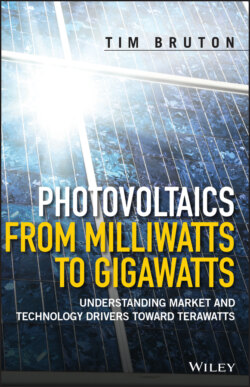Читать книгу Photovoltaics from Milliwatts to Gigawatts - Tim Bruton - Страница 19
1.3.2 Continuing Research for Space
ОглавлениеThe emergence of solar cells as the only viable power source in space, coupled with the competition between the United States and Soviet Union over leadership in the space race, stimulated further research. Between 1958 and 1969, the US government provided $50 million for solar cell research. In 1961, the USARDL demonstrated a 14.5%‐efficient solar cell similar to the Telstar cell [48]. But, remarkably, while the industrial production of space solar cells ramped up, their efficiency showed no increase between 1961 and 1970, as illustrated in Figure 1.10 [49].
Figure 1.10 Evolution of recorded mono‐ and multicrystalline silicon solar cell efficiencies, 1940–2010 [49]
(Courtesy Wiley) Source: M.A. Green: Progress in Photovoltaics‐Research and Applications 17 (2009) 183–189
Increasing radiation resistance had been prioritised over increasing solar cell efficiency. Reducing cell cost was also not a major concern. By 1970, attendance at the 8th IEEE PV Specialists Conference had fallen to only 100 delegates. The next milestone after the USASRDL 14.5% cell was the 15.2%‐efficient cell reported by Comsat Laboratories in the United States in 1973. COMSAT (Communications Satellite Corporation) was founded in 1962 to develop commercial communication satellites, and in 1969 it established its own research laboratories. In 1972, it reported the first violet cell, which had a very lightly doped emitter 0.1 μm deep with a sheet resistance of 500 Ω/cm, requiring many fine grid lines (30 per centimetre) to minimise series resistance, as well as tantalum pentoxide ARC to allow more blue light into the cell [50]. The initial efficiency reported was 13%, but this was quickly improved to 14% [51]. The cell was shown to maintain its higher efficiency compared with standard commercial cells after 1 MeV electron irradiation. However, it was soon overtaken at COMSAT by the chemically textured cell. This involved silicon wafers textured using dilute alkali etching of (100) orientation silicon. The (100) direction etched faster than the (111), so that pyramids typically 2–3 μm across the base formed on the surface, as shown in Figure 1.11. This greatly reduced reflection, as incident light reflected from one pyramidal surface impinged an adjacent one and so was absorbed. The pyramidal structure also enhanced current collection by refracting the incoming light so that it was more parallel to the collecting p/n junction. COMSAT reported a 15.5% efficiency [51], but this was rapidly increased to 17.2% [52] without loss of radiation hardness.
Another approach to increasing solar cell efficiency involved using higher‐resistivity wafers, as these had longer minority carrier diffusion lengths, giving higher short‐circuit currents. However, this came at the cost of a lower Voc, so that there was an overall loss in efficiency [53]. It was also desirable to decrease the wafer thickness in order to improve the electrical yield per unit weight – an important consideration for satellites. It was shown experimentally that Voc above 580 mV could be obtained by a ‘gettering process’ [54]. Further experiments showed that firing an aluminium rear contact produced good results and that a thickness reduction to 200 μm was possible without loss of efficiency and with good radiation hardness [54]. The aluminium rear surface could also act as back surface reflector of light, contributing to improved current generation. The cells produced were termed back surface field (BSF) cells, and at the standard thickness of 300 μm they increased the solar cell efficiency from 9.3 to 11.6%. The mechanism for efficiency improvement was a combination of the p+ doping at the rear creating an internal electric field that repulsed the minority carrier electrons and a gettering action removing impurities from the silicon introduced in processing to give a high minority carrier lifetime. In later years, the BSF approach represented a useful enhancement in terrestrial solar cells.
Figure 1.11 Textured (100) monocrystalline silicon wafer.
Source: Courtesy BP Archive
This was all demonstrated in the mid‐1970s, by which time research for terrestrial applications had begun and further advances in efficiency were being made for terrestrial silicon cells, as described in Chapter 4. Meanwhile, developments in space cells turned toward III–V materials, as described in section 1.4.
